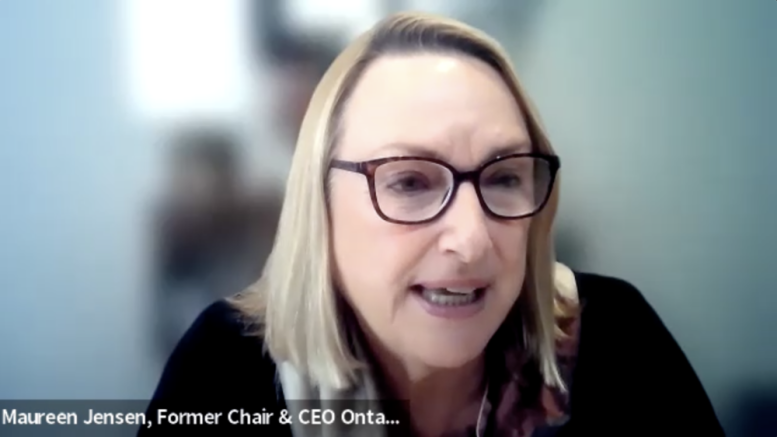The brisk, sweeping changes Industry 4.0 brings to the financial landscape are forcing miners to rethink how they operate while regulators closely watch and prepare to implement new rules to curb fraud and criminal activity, says industry doyen Maureen Jensen.
The former CEO of the Ontario Securities Commission (OSC) told The Northern Miner‘s recent Global Mining Symposium that the scale of change has seen the digitizalization of every facet of our modern financial system, including how miners dig holes in the ground.
“Everything is digital today. There are only one or two exchanges that still have open outcry floors. In North America, everything has gone digital,” she said. “But even more important than that, the financial markets have gone global. And that is a huge change.”
According to Jensen, as a result, regional exchanges have lost prominence. Most large companies are now multi-listed in various jurisdictions, some of them even listed enough to trade almost 24 hours a day.
“What we’re seeing today is the advent of digital finance. This includes crypto — most regulators are now looking at crypto assets of all kinds — and non-fungible tokens. All kinds of things can be listed and traded on an exchange. Fractional shares have turned into a large business,” Jensen said.
The rise of sustainable investing is another way the financial landscape is evolving. The largest institutional shareholders have always driven markets, and Jensen pointed out that critical companies such Vanguard and BlackRock, with their significant positions in many funds, are changing the world via policy directives.
“We’re also seeing new kinds of exchanges like the Neo Exchange. They’re constantly looking for new things. And there is a change in the type of exchanges, the listing criteria, and the amount of information you can collect daily.”
Jensen said miners had traditionally been innovative “when they had to,” and the rise of the digital economy is one of those moments in time the industry would have to adapt to continue accessing reasonable financing since today, that comes with ESG strings on the side.
Amidst all this change, Jensen also noted that surveillance has caught up. “Today, surveillance is done with artificial intelligence and algorithms. It’s a different world,” she said. .
“And it’s a world that mining is very involved with, and so people will see mining shares, over multiple markets, moving very high volumes. How are these mining securities moving so quickly? Because of those third-party wholesalers, they were moving the markets themselves with their algorithms,” Jensen said.
World in flux
Meanwhile, Jensen also pointed to a period of instability and volatility facing the macro landscape as the world bifurcates into two solitudes: Russia and China on one side and the rest on the other.
“That is going to change everything,” Jensen said. “We’ve already seen what it does to the oil and gas price. Also, the oil and gas industry hadn’t been exploring much lately because of the price changes a while ago. And the fact is, there’s not a lot of people financing them for that. So, we can see that we’re going to have oil prices move up.”
On the people front, Jensen noted a steady influx of a more diverse, inclusive set of mining executives. Still, she expects a talent war is brewing as the ‘Boomer time’ is coming to a close with fewer people in younger generations interested in working in mining.
“I would suggest that the most important thing is to focus on your risks. And if there’s a way that a sustainability guideline or goal can help you address a risk, use it,” Jensen said. “Focus on what you can do, don’t focus on ‘happy talk.’
“You’re going to have to have a more diverse workforce; you’re going to train more. You will have to look at how you can interact with your communities better.
“Given what’s happening on the macro side, think about diversifying your supply chain of critical products that you need access to because we’re going to have armed conflicts, I think, and that’s a scary thing to say.”
The former OSC chief further explained that mining will be as necessary 100 years into the future as it was 100 years ago.
“You’re just going to have to focus on how you get the social licence to do that. And you do that by being a good corporate citizen and having well-trained people who love working for you,” Jensen said.
Distinguished career
Jensen attended the University of Toronto, where she earned a B.Sc. in geology in 1979. She is perhaps best known for her role as the first female to head the OSC. She championed policies to improve investor protection and encourage diversity for executives and directors of public companies.
Before joining the OSC, Jameson served as the Senior VP for surveillance and compliance at the Investment Industry Regulatory Organization of Canada and president of market regulation services.
She also held senior positions at the Toronto Stock Exchange, including director of mining services during the aftermath of the Bre-X Minerals scandal. She was a TSX member of the mining standards task force that laid the groundwork for National Instrument 43-101. That measure became a globally recognized disclosure standard for mining projects.
Jensen will be inducted into the Canadian Hall of Fame later this year. “For me, this is like getting an Oscar, this is that great,” she said.
“If you look at that incredible list of people in the mining Hall of Fame, I thought: ‘No, I haven’t found a mine. But I’ve loved this business.’ It’s thrilling that the Mining Hall of Fame is looking broader than simply these incredible people who find mines and discover new processes,” Jensen said.
“Mining is a life. It’s a calling. And now we’re seeing more people who have really changed rules and made certain that mining is part of the Canadian lifestyle.”


Be the first to comment on "GMS: Maureen Jensen on the ‘advent of digital finance’"